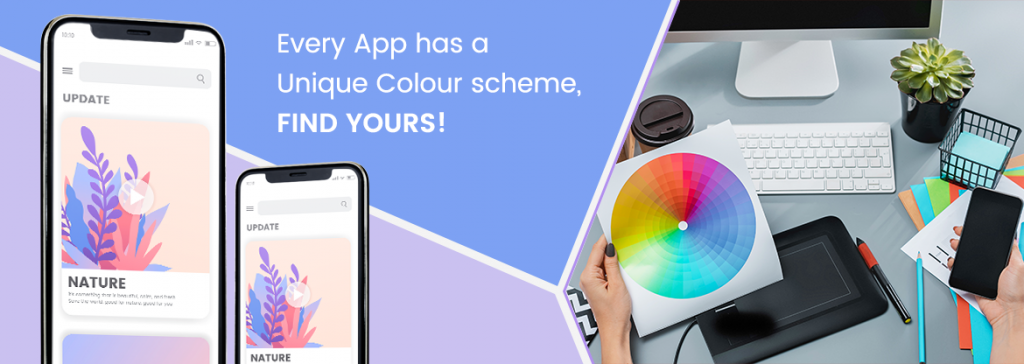Why is picking the right colours important?
Colour being the second most important after the functionality of your app plays a crucial role in creating a staunch impression among the users. Picking the right sets of colours is pivotal for the reliability of a brand, which can ensure a higher conversion rate at first glance.
‘Aye’ to an effective colour scheme
Nominating an effective colour scheme is vital not only for aesthetic reasons but for smoother navigation throughout the app by users. It is important to learn that each colour imparts a specific yet different message to the viewers. Hence, mastering the basic colour psychology is a must before picking the right palette to lure your target audience.
Like, social media platforms use vivid and vibrant colours announcing communication, efficiency and trust among users. Mark Zuckerberg used blue colour for the famed social media portal Facebook, which is one of the reasons for its popularity and success. Mark indeed used a simple yet effective colour to attract people worldwide to use the app. Facebook navigation has never been a struggle for anyone. Kudos the simplest colour palette used by the founder.
Handpicking the right one
So far we came to know that each colour disseminates a specific message to the viewer. Your audience has three options while looking at the app- Yes, No and Wow! Remember choosing a few colours, preferably three at once, is best suited for all purposes. Using many can create disillusionment, turning off your user’s interest.
Users judge an app at the very first glance. Hence, designers are burdened with choosing the right scheme and palette to convey the message easily without overwhelming them.
The Assimilating factor
The preferable number of colours you can experiment with is “three”. Although this doesn’t limit you from using more than the suggested numbers. In the end, you know your target audience better than anyone and hence you are the sole decision-maker of the number of colours in your app to set forth the idea in the right place. Only one thing to be cautioned about is not making your users feel inundated. A simple colour scheme makes the User Interface easy to connect with.
1. Monochrome
Monochromatic colours fabricate a calming effect without straining the eyes. This is known to be one of the simplest colour schemes. The colour palette is pointed at a single colour known as the base colour and all the other colours are taken from it. With a monochromatic scheme, your UI will look clean and demulcent to the users.
2. Analogous
Such schemes are created using related colours. Three colours standing adjacent to each other on the colour wheel are known as Analogous.
An effortless way to pull off an effective scheme. The tricky part is to choose the colour that will impart vibrancy and will be hyperbolic. For example, using the analogous blue and green colour scheme will be great to create a relaxing and soothing effect for a meditation app. While using the yellow and orange analogous colour scheme for a clear and motion driven app will spell out the prioritization of the current set of tasks.
3. Complementary
In the colour wheel, colours placed at 180 degrees to each other are known as complementary. They are used to attract the attention of user’s as they contrast strongly. One simple rule to follow here is electing the dominant colour and using the complimentary one for accentuation.
But you have to be very careful while using complementary colours to avoid a visual imbroglio look. Like, using green as the dominant colour and red for the striking effect for a messaging app.
Design your own palette
You always have the sovereignty to create your own colour scheme. The most favoured colour palette is a neutral one with a vibrant colour to contrast visually.
Contrast does the work
The contrast ratio is to be taken into consideration to make the content readable without stressing out one’s eyes. Readability is defined by the ratio factor between the base colour and text colour. The content should be easy to understand even for users with visual impairments
Contrast means how one colour stands apart from the other. When used meticulously, it mitigates eye fatigue and makes it easier for the user to focus on different elements by distinguishing them.
A readable text
The commonly used colour ratio is 1:1 or 21:1 to make text readable on the base colour. A lofty difference between the two numbers signifies a higher disparity between the relative luminance of the two colours. The W3C recommends the following-
> The contrast ratio between small text and the background should be 4.5:1
> The contrast ratio between large font (14pt/ 18pt and up) should be 3:1 contrary to the background.
Capturing user’s attention
Contrast not only make the text readable but also diverts the user’s attention towards distinguished elements on a screen. High contrasts are generally used for key elements. This also determines whether or not the user is going to click on something specific. It has been observed that users are more likely to click on a call-to-action button that stands out against the background
Focusing colour blindness
When colour blindness is discussed people usually refers to the inability to recognize certain colours. It’s been learnt that approximately 8% male and 0.5% females are incompetent to comprehend a few colours. Red and Green being the most complicated combination to perceive.
Because colour blindness can take certain forms, it is important for you to make the app user compatible. Using different visual cues to communicate the important elements in the app will be a smart choice to pick. It is advised not to rely on a single colour to stipulate system status. Instead, use strokes, indicators, patterns, text, textures, naming a few elements to catalogue actions and content.
Final Verdict
Before jumping into designing, UI/UX designers are required to do much R&D about the target audience. The colour scheme is going to enhance the User Interface if chosen correctly. A good designer is familiar with the minute details of hues related to different colours.
Remember, to create a magnificent, exuberant and functional colour scheme a lot of practice and user testing is needed.
The proficient team of designers at Qualhon will serve the purpose of delivering attractive yet impactful designs for your business.
Reach out to us today and get a free quote!



